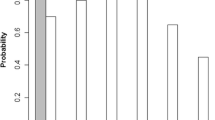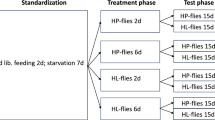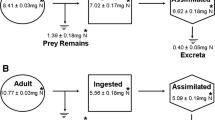Summary
The influence of feeding constraints on the feeding behaviour of Diaea sp. indet., was investigated. Diaea is a crab spider which ambushes its prey and practises extraintestinal digestion. A laboratory study was carried out using fruit flies, Drosophila immigrans, as prey. Diaea feeds from two sites on the prey — initially the head, followed by the posterior abdomen, with most of the prey's contents being extracted from the head. If additional prey are available, Diaea will, instead of switching to the posterior abdomen, catch a new prey item. The efficiency with which Diaea can extract food is influenced by changes which occur in the prey as a consequence of it being killed and fed on. Evaporative fluid loss from prey is an important constraint on food uptake because in influences the viscosity of the prey's contents. Regardless of whether a new prey item arrives, Diaea discards the prey item on which it is feeding before all of the available food has been extracted from it. The fluid content of the prey is not only part of the food the spider extracts, it is also a resource enabling efficient transfer of food from prey to predator. The value of the prey's fluid content as a resource decreases as a function of feeding time and as a consequence of the spider feeding on the prey.
Similar content being viewed by others
References
Bailey PCE (1986) The feeding behaviour of a sit-and wait-predator, Ranatra dispar (Heteroptera: Nepidae): optimal foraging and feeding dynamics. Oecologia 68:291–297
Bartels M (1930) Über den Freßmechanismus und chemischen Sinn einiger Netzspinnen. Rev Suisse Zool 37:1–42
Bernays EA, Simpson SJ (1982) Control of food intake. Adv Insect Physiol 16:59–118
Cheverton J, Kacelnik A, Krebs JR (1985) Optimal foraging: constraints and currencies. In: Holldobler B, Lindauer M (eds) Experimental behavioral ecology. Fischer Verlag, Stuttgart, pp 109–126
Collatz KG, Mommsen T (1974) Lebensweise und jahreszyklische Veranderungen des Stoffbestandes der Spinne Tegenaria atrica CL Koch (Agelenidae). J Comp Physiol 91:91–109
Cook RM, Cockrell BJ (1978) Predator ingestion rates and its bearing on feeding and the theory of optimal diets. J Anim Ecol 47:529–547
Dethier VG, Evans DR, Rhoades MV (1956) Some factors controlling the ingestion of carbohydrates by the blowfly. Biol Bull 111:204–220
Formanowicz DR Jr (1984) Foraging tactics of an aquatic insect: partial consumption of prey. Anim Behav 32:774–781
Griffiths D (1981) Sub-optimal foraging in the ant-lion Macroleon quinquemaculatus. J Anim Ecol 50:697–702
Haynes DL, Sisojevic P (1966) Predatory behaviour of Philodromus rufus Walckenaer (Araneae: Thomisidae). Can Entomol 98: 113–133
Holling CS (1966) The functional response of invertebrate predatiors to prey density. Mem Entomol Soc Can 48:1–86
Kingsolver JG, Daniel TL (1979) On the mechanics and energetics of nectar feeding in butterflies. J Theor Biol 76:167–179
Kruse KC (1983) Optimal foraging by predaceous diving beetle larvae on toad tadpoles. Oecologia 58:383–388
Lucas JR (1985) Partial prey consumption by antlion larvae. Anim Behav 33:945–958
Morse DH (1979) Prey capture by the crab spider Misumena calycina (Araneae, Thomisidae). Oecologia 39:309–319
Morse DH (1981) Prey capture by the crab spider Misumena vatia (Clerck) (Thomisidae) on three common native flowers. Am Mid Nat 105:358–367
Morse DH (1984) How crab spiders (Araneae, Thomisidae) hunt at flowers. J Arachnol 12:307–316
Morse DH, Fritz RS (1982) Experimental and observational studies of patch choice at different scales by the crab spider Misumena vatia. Ecology 63:172–182
Pollard SD (1988) Partial consumption of prey: the significance of prey water loss on estimates of biomass intake. Oecologia 76:475–476
Sih A (1980) Optimal foraging: partial consumption of prey. Am Nat 116:281–290
Sittertz-Bhatkar H (1980) Oral cleansing in spiders is gland mediated! Z Naturforsch 35:669–673
Ward P, Enders MM (1985) Conflict and cooperation in the group feeding of the social spider Stegodyphus mimosarum. Behaviour 94:167–182
Author information
Authors and Affiliations
Rights and permissions
About this article
Cite this article
Pollard, S.D. Constraints affecting partial prey consumption by a crab spider, Diaea sp. indet. (Araneae: Thomisidae). Oecologia 81, 392–396 (1989). https://doi.org/10.1007/BF00377089
Received:
Accepted:
Issue Date:
DOI: https://doi.org/10.1007/BF00377089




